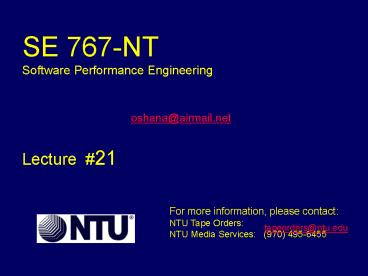Designing User Interfaces Spring 1999 - PowerPoint PPT Presentation
1 / 38
Title:
Designing User Interfaces Spring 1999
Description:
Web applications and other distributed systems ... Performance anti-patterns. Implementation solutions. Web applications ... Performance gain; Ts = Ms X O ... – PowerPoint PPT presentation
Number of Views:39
Avg rating:3.0/5.0
Title: Designing User Interfaces Spring 1999
1
SE 767-NT Software Performance Engineering Robert
Oshana Lecture 21 For more
information, please contact NTU Tape
Orders NTU Media Services (970) 495-6455
oshana_at_airmail.net
tapeorders_at_ntu.edu
2
(No Transcript)
3
Performance Antipatterns
- Chapter 11
4
Where we are
- Introduction
- SPE Quick View
- SPE and the UML
- Software Execution Models
- Web applications and other distributed systems
- System execution models
- SPE data collection
- Software measurement and instrumentation
- Performance oriented design
- Performance patterns
- Performance anti-patterns
- Implementation solutions
- Web applications
- Embedded and real-time systems
- The SPE process
- Implementing SPE
5
Overview
- Antipatterns are conceptually similar to patterns
- Document recurring solutions to common design
problems - Their use or misuse produces negative
consequences - Document common mistakes
6
Overview
- May be more useful than patterns
- Antipatterns are refactored to overcome their
negative consequences
7
god class
- One that performs most of the work of the system
- Relegates other classes to minor supporting roles
- A single complex controller
- Other classes are primarily container classes
8
(No Transcript)
9
Controller code snippet
10
Refactored solution
11
Refactored Controller code snippet
12
More on the God class
- A result of poorly distributed system
intelligence - May creep into design in several ways
- Creates problems by causing excessive message
traffic
13
(No Transcript)
14
Things to watch for
- An object that must request lots of data from
other objects and then update their states with
the results - A group of objects that must access a common
object to get and update the data that it deals
with - Performance gain Ts Ms X O
- (Ts is processing time saved, M messages
saved, O overhead/message
15
Excessive Dynamic Allocation
- Dynamic allocation create objects when first
accessed and destroy when no longer needed - But this is expensive
- Performance impact if this is done often
16
(No Transcript)
17
Cost of dynamic allocation
- N calls
- depth contained objects that must be created
when the class is created - sc, sd service time to create and destroy
18
(No Transcript)
19
Two possible solutions
- Eliminate the need for object creation and
destruction by recycling objects from a pool - Use sharing to eliminate the need to create new
objects - Flyweight pattern
20
Circuitous treasure hunt
- Typically found in DB applications
- Retrieve data from one table to search a second
table, etc - Large amount of DB processing required
- Remote server access even worse
21
(No Transcript)
22
(No Transcript)
23
Circuitous treasure hunt
- Also found in OO systems that have large
response sets - Look for option of selecting a different data
organization - Select a data organization that puts the data
close to where it will be used
24
(No Transcript)
25
One lane bridge
- Traffic that may only travel in one direction at
a time - A point in execution where one or only a few,
processes may continue to execute concurrently - All others must wait
- Occurs in DB applications mainly
26
(No Transcript)
27
One lane bridge
- Provide additional paths
- Use an algorithm for assigning new DB keys
- Use multiple tables that may be consolidated
later - Preloading
- RT S / (1 XS)
28
(No Transcript)
29
Traffic jam
- Transient behavior that produces wide variability
in response time - Cause of problem seldom visible
- Sometimes related to One Way Bridge (solve by
reducing effect) - If caused by periodic high demand, seek
alternatives that spread the load
30
Traffic jam
- Know the limits of scalability of the system
before you build it, and plan for handling
overload situations smoothly
31
(No Transcript)
32
Implementation solutions
- Chapter 12
33
Where we are
- Introduction
- SPE Quick View
- SPE and the UML
- Software Execution Models
- Web applications and other distributed systems
- System execution models
- SPE data collection
- Software measurement and instrumentation
- Performance oriented design
- Performance patterns
- Performance anti-patterns
- Implementation solutions
- Web applications
- Embedded and real-time systems
- The SPE process
- Implementing SPE
34
Overview
- Early lifecycle activities are required
- Having a good architecture and design, however,
does not guarantee that you will meet your
performance objectives - Various reasons to tune application
- Initially developed without SPE
- Choices for data structures or other
implementation alternatives not optimal - Language has some hidden features
- Must meet new unanticipated performance
35
Performance tuning
- Process of transforming code that fails to meet
performance objectives into better performing
code that performs an equivalent function - Usually conducted late in lifecycle
- Must focus on areas of biggest payoff
36
Performance tuning process
- 1. Prepare test plans that identify measurements
to be taken and objectives - Identify performance problems
- Identify important workloads
- Characterize properties of workloads
- Define data required
- Identify measurement tools needed
37
(No Transcript)
38
SE 767-NT Software Performance Engineering Robert
Oshana End of lecture For
more information, please contact NTU Tape
Orders NTU Media Services (970) 495-6455
oshana_at_airmail.net
tapeorders_at_ntu.edu































